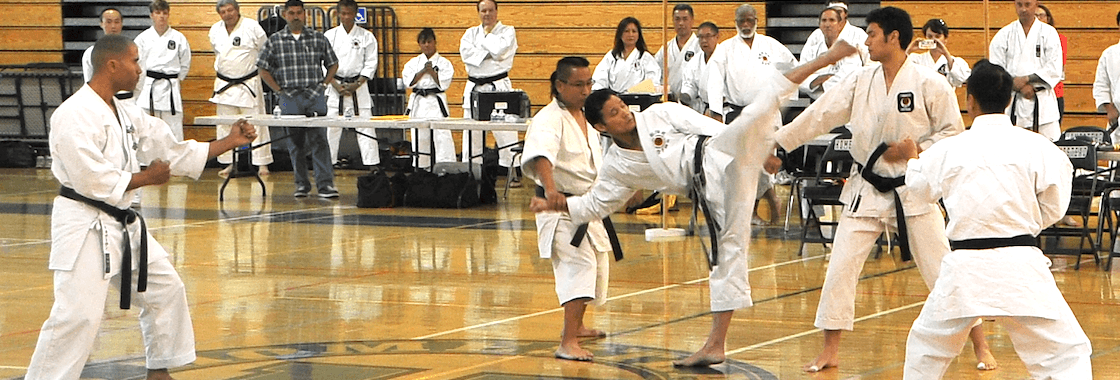
“The ultimate aim of karate lies not in victory or defeat but in the perfection of the character of its participants” ~ Master Funakoshi GichinFacebookInstagramYelpYoutubeLinkedinQuestionEnvelope
FSKA TOURNAMENT RULES, CODE, AND CONDUCT
TOURNAMENT RULES: KUMITE
Point System
- Most matches are two waza ari or one ippon.
- Black belt adult finals are four waza ari or two ippon.
- If time is up before the necessary points are scored, the judges will make decision based upon contact warnings, jogais, points, aggressiveness, size, differences and superiority.
- All warnings will carry over to extension matches.
Criteria for One Point (ippon)
- A Technique delivered that would have rendered the unconcious if it were not controlled. It combines quick acceleration and rhythm, perfect timing and distance, and incredible strength.
- When a technique is delivered to an opponent who does not attempt to block or move.
- When a technique is delivered in instant before the opponents attacks.
- After a sweap when an effective is delivered before, or at the same instant, the opponents hits the floor.
Criteria for Half Point (wasa ari)
- When a technique is delivered that would have disabled an opponent if not controlled. It combines speed, power, form, balance and control.
- When an effective technique is delivered immediately after an opponents swept to the floor.
Stepping Out of the Ring (jogai)
- First time is jogai ikkai (no point awarded).
- Second time is jogai nikkai (no point awarded).
- Thirs time is jogai sankai (half point to opponent).
- Fourth time is jogai yonkai (half point to opponent).
- Judge will decide jogai warnings based on size, attempts to stay in the ring, slipping, etc…
- In black belts adult finals, after jogai yonkai, the judge will continue to award a half point to the opponent.
Length of Matches
- Most matches will be two minutes.
- black belts adult finals will be three minutes.
- All extension matches shall be one minute. The first contestant to score in the extension match wins.
- In the final match (if not before). In a 3rd and 4th place match, a winner must be chosen by the end of the second extension match (if not before). A winner must be chosen after the first extension in any other match.
Target areas
- Entire Head – front, side, and back (light to no contact).
- Front of body – from the chest to stomach.
- Side of body – from armpits to above hips.
- Back of body – entire back (except spine).
Contact
- Light Warning – Keikoku (no point to opponent).
- Moderate – Hansoku Chui (half point to opponent).
- Excessive – Hansoku (disqualification).
- Shikaku – Contestant must leave the tournament.
- Any two keikokus equals a hansoku chui.
- in giving warning, judges will consider excessiveness, size differrences, face mask, and/or moving in or away from the target.
Non-Contact
- Head, neck throat, spine, groin, collarbone, knees.
- No attacks below the belt, except sweeps to the ankles.
Restrictions
- No pushing, throwing, or grabbing and pulling.
- All coaches, instructors, spectators, contestant, and volunteers MUST control their actions. If behavior / words are deemed disrespectful or bothersome, the individual(s) involved maybe asked to leave the tournament site.
Equipment
- Mandatory, mouthpiece, knuckle pads, and cup (males).
- Optional: face mask, chest protector, and shin or foot pads.
- Any questionable equipment must have the approval of the ring official or tournament director.
Officials
- Both the corner judge and the chief judge shall only have the power of one vote.
- There must be at least three votes to determine a waza ari or ippon.
- There must be at least two votes to determine a warning.
- Chief judges cannot wave down three flags unless corner judges change their minds after a judge’s meeting or different judges see different techniques.
- At least end of a match, if the score is 0-1, the chief judge must still call for “hantei”.
TOURNAMENT RULES: KATA
Katas
- Color belts should perform lower level katas (Heians)
- Brown belts should perform intermediate level katas
- Black belts should perform advanced level katas.
Criteria of Points
- Contestants must demonstrate courtesy by bowing respectfully to the chief judge before and after the kata.
- Katas should be performed with strong stances, correct timing and rhythm, focus, spirit (kiai), proper movements, and no hesitations.
- Contestants performing a basic kata well should receive a higher score than a contestant who performs the above criteria average or poorly with an advanced kata.
- Advanced katas require good basic and quick/fluid movements that are natural. If a contestant performs an advanced kata with only basic movements and mechanical rhythm, the kata will be judged as a basic kata.
Non-influencing Factors
- Applause of cheers from spectators.
- Excessively long or extra kiais.
- Gymnastic type movements.
- Vibrating hands to stimulate kime.
- Theatrics and over-acting.
- Crowd favorites.
- Students, family, or friends competing.
Scoring
- Of the five scores, the high and low will be taken out.
- The three remaining scores are added to reach a total score.
- In the event of a tie, the lowest score will be added.
- If there still a tie, the highest score will be added.
- if a tie remains, the intermediate and advanced contestants perform a different kata. Beginners perform the same kata.
- An average of 6.0 is used for beginners and intermediates, 6.5 for brown belts, and 7.0 for black belts.
TEAM KATA AND KUMITE DIVISIONS
Team Kata
- The criteria for the team kata will be based on the synchronization of the performers as well as the criteria for the individual kata requirements.
Team Kumite
- All matches are Shobu Ippon.
- The length of the matches is two minutes.
- If a match ends in a draw, there will be no extensions.
- The winning team is decidd by the most matches won, not by the number of waza ari accumulated.
- After all team members have competed, in the event of a tie, the team will decide who goes up to break the tie (the same person cannot go up again if the tiebreak match is draw). This is a new match, not an extension match, therefore, all previous warnings do not carry over as in individual extension matches.
- In the finals, a winner must be chosen by the end of the third tiebreak match (if not before). In deciding 3rd and 4th, a winner must be chosen by the end of the second extension match (if not before). In any other match, a winner must be chosen after the first tiebreak match.
- If not mutually agreed upon, to determine the order of contestants, the chief judge will flip a coin. The team winning the toss decides which team sends a contestants up first. The other team then sends someone up to complete. During the next round, the other team sends someone up first.
NOTE:
These Rules was originally made by FSKA and adapted ONLY by LEKCI USA, LEKCI Philippines, LEKCI Qatar, LEKCI Jeddah, and other LEKCI Chapters. LEKCI is an affiliate member of FSKA / FSKA Premier World Headquarters Milpitas, California, U.S.A.



